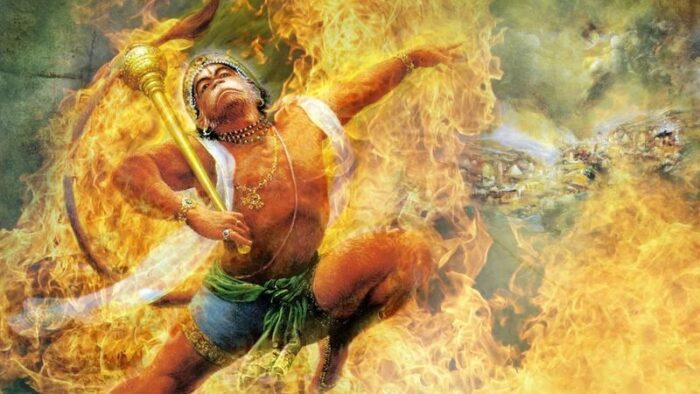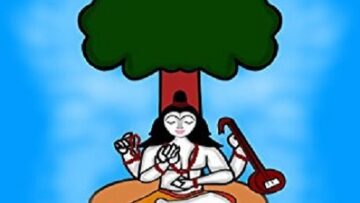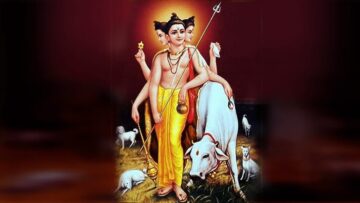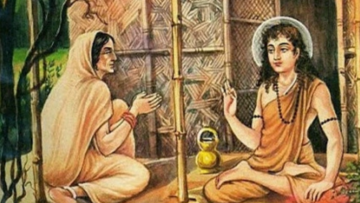Ramayana is one of the holiest, most revered epics in Santana Dharma. Adi Kavi Valmiki’s magnum opus on the life and times of Sri Rama finds a special place in everyone’s hearts and homes. Spanning over 7 kandas, this epic captures the life of Sri Rama from the time of his birth to the final ikya with the moola swaroopa in great detail.
Sri Rama is undoubtedly the most studied, most revered heroes from the annals of our rich ancestry. While Rama continues to the primary point of interest, there is a greater interest in the interplay of other characters from the epic who hold a special place with Sri Rama.
Sri Rama shared a very special relationship with everyone around him which is captured in excruciating detail in the epic. While the interplay amongst the various characters is of common interest, human mind yearns for the lesser known, yet equally interesting interactions amongst other characters in Ramayana.
Sundara Kanda is one of the most chanted, most revered, divine and perhaps lengthier sections of Ramayana. This kanda traces the narrative from Hanuman’s travel to Lanka to his meeting Seetha followed by the burning of Lanka & finally conveying the message of Seetha to Sri Rama. There are many equally interesting sub-sections of specific interest like Trijata Swapna, the dream of Trijata.
Amongst these various narratives, lies a very interesting, invigorating incident where Hanuman and Ravana come face-to-face for the first time. When Hanuman would have travelled to Lanka, he would have traversed through various lanes, by-lanes of Lanka including Ravana’s palace, regaling at the riches of the iconic island.
This article captures some key, perhaps lesser known interesting anecdotes from Sundara Kanda, starting with Hanuman’s activities in Lanka leading up to his subsequent meeting with Ravana. Beyond the normal narrative, if we one delves deeper, there are some invaluable lessons that could be derived for daily life.
ātmānaṁ rathinaṁ viddi śarīraṁ rathamēva tu
buddiṁ tu sārathiṁ vid’dhi manaḥ pragrahamēva ca
Know that (individual) self as the master of the chariot, the body as chariot. Know the intellect as the charioteer, and the mind as verily the bridle.
Kaṭhōpaniṣat defines the relationship between atmanam, sariram, buddhi and manah in the form of this timeless wisdom.
Hanuman is perhaps one of the finest, most apt examples of what one could achieve if they channelized their intellect and body. After meeting Seetha, he takes a few steps and starts pondering to himself.
अल्प शेषम् इदम् कार्यम् दृष्टा इयम् असित ईक्षणा |
त्रीन् उपायान् अतिक्रम्य चतुर्थ इह दृश्यते || ५-४१-२
I have seen this black-eyed Seetha. There is only a little that remains to be done by me. Abandoning the three strategies for success viz. sowing dissension, negotiation and bribery, I have to implement here the fourth strategy viz. open assault.
His mandate was to establish contact with Seetha, convey the message of Sri Ram and perhaps take back a souvenir of his meeting. Hanuman was clearly impressed and perhaps mesmerized with the opulence and riches of Ravana’s kingdom. After achieving his objective, Hanuman could have returned to his waiting friends on the other side of the ocean. Yet, he chose a different path.
Hanuman’s sudden change of heart would pique anyone, for the reason for such an adventure is unclear. Yet, the great hero choses to answer this to the readers himself.
कार्ये कर्मणि निर्दिष्टः यो बहूनि अपि साधयेत् |
पूर्व कार्य विरोधेन स कार्यम् कर्तुम् अर्हति || ५-४१-५
He alone can accomplish his purpose, who implements many (secondary) tasks even after the initial task has been carried through, without impairing the previous achievement.
Quick witted, wise Hanuman provides such timeless wisdom in such an effervescent manner. Hanuman stresses the need for one to stretch beyond the primary task and focus on additional tasks. This should be quite familiar to many, given the resonance one can find in comparison with the modern-day corporate world.
Hanuman goes on to elaborate on how one should achieve their task. Should one ignore menial tasks?
न हि एकः साधको हेतुः स्वल्पस्य अपि इह कर्मणः |
यो हि अर्थम् बहुधा वेद स समर्थो अर्थ साधने || ५-४१-६
There is indeed no single exclusive method to accomplish a purpose however small a task may be. On the other hand, whoever knows to do a task in many ways, he alone is capable of achieving that task
Hanuman displays impeccable attention to detail with focussed approach at the same task in the hand. He sets a magnanimous example of how one should approach any situation in life. With such a thought, Hanuman decides to take up his secondary task. The question that remain is, what exactly is this task and more importantly, why is Hanuman trying to take up the same.
This is answer by the parama Ram-bhaktha as thus
इह एव तावत् कृत निश्चयो हि अहम् |
यदि व्रजेयम् प्लवग ईश्वर आलयम् |
पर आत्म सम्मर्द विशेष तत्त्ववित् |
ततः कृतम् स्यान् मम भर्तृ शासनम् || ५-४१-७
If I go to the abode of Sugreeva the Lord of monkeys, having ascertained the truth as to who will predominate in an encounter between the adversary and ourselves here itself, then will the command of my master have been carried out by me.
This is a prime example of displaying an acute, sharp presence of mind. Hanuman is currently in enemy territory and takes up a challenge to perform strategic reconnaissance of the enemy in the upcoming conflict. This single act reflects the sharp intellect of the trust general of Sugreeva, which could provide key intelligence to prepare for the war.
Finally, he sets the goal of his activity i.e. meeting with the towering Ravana.
ततः समासाद्य रणे दशाननं |
समन्त्रिवर्गम् सबलप्रयायिनम् |
हृदि स्थितम् तस्य मतम् बलं च वै |
सुखेन मत्त्वाऽहमितः पुनर्व्रजे || ५-४१-९
Then meeting Ravana with his troop of ministers, his army and his followers in battle as well as knowing his designs and strength, I will go back from here happily.
He wants to meet the famous Ravana, for he wishes to gauge his strength & valour before he goes back from his mission.
Hanuman, the intelligent warrior, devises a plan to get the attention of Ravana’s army. He decides to wreak havoc on the fabled garden of Ravana which looked like Nandana, Indra’s garden.
The news of the devastation soon reaches Ravana’s ears and asura after asura are dispatched to deal with the offender. Unfortunately for those poor souls, they met at their end at the hands of Hanuman. The intrigue grows more stronger that Seetha was talking to him and only her place isn’t destroyed by Hanuman.
He announces himself in a grand manner ..
दासोऽहम् कोसलेन्द्रस्य रामस्याक्लिष्टकर्मणः |
हनुमान् शत्रुसैन्यानाम् निहन्ता मारुतात्मजः || ५-४२-३४
I am Hanuma, the destroyer of the army of adversaries and the son of wind-god. I am the servant of Rama, the king of Kosala Kingdom, who is unwearied in action.
And throws a challenge to the famed king of Lanka, Ravana… The first strike
न रावणसहस्रम् मे युद्धे प्रतिबलं भवेत् |
शिलाभिस्तु प्रहरतः पादपैश्च सहस्रशः || ५-४२-३५
Even a thousand of Ravanas will not be matching equally with me, who is capable of striking with thousands of rocks and trees in battle.
This is a pretty interesting phrase. On one end, it oozes supreme confidence in one’s own abilities, while also triggering the opponent to take up the challenge.
Hanuman doesn’t stop only with the garden, but proceeds to destroy the uttamam chaitya praasaadam i.e. sanctuary i.e. sacred to the guardian deity of asuras.
Ravana’s soldiers are killed one after another with relative ease by Hanuman, leading to former’s agony. Ravana dispatches Virupaksha, Yupapaksha, Durdhara, Praghasa & Bhasakarna, his 5 fearsome generals.
The interesting aspect of this episode is that Ravana is not aware of the real reason for the ongoing destruction. He still considers this to be a conspiracy by Indra.
भवेत् इन्द्रेण वा सृष्टम् अस्मत् अर्थम् तपो बलात् |
सनाग यक्ष गन्धर्वा देव असुर महर्षयः || ५-४६-७
This evil spirit may be some being evolved for our sake by Indra the Lord of celestials with a strength of his askesis. Celestials, demons, sages along with Nagas the serpent-demons, Yakshas the spirits and Gandharvas the celestials musicians were conquered by my along with you all together
Hanuman kills all the generals after a fierce battle leading to Ravana sending his son, Aksha to fight against him. Unfortunately for Ravana, even Aksha meets his end at the hands of Hanuman.
After suffering heavy losses, Ravana orders his son Indrajit to go for a battle against Hanuman. The two supreme warriors face-off against each other and are a match. Indrajit’s battle prowess proves futile in front of Vayu putra.
Finally, Indrajit uses the Brahmaastra, which binds Hanuman.
ततः पैतामहम् वीरः सोऽस्त्रमस्त्रविदाम् वरः |
संदधे सुमहातेजास्तम् हरिप्रारम् प्रति || ५-४८-३६
That warrior, Indrajit, excellent among the knowers of missiles and possessing a great splendor, then fitted to his bow, a missile presided over by Brahma the creator.
Hanuman realises that he is rendered motionless by none other than the astra presided over the creator, Brahma. Hanuman recollects a boon that he has received from Brahma and decides to obey the astra. Hanuman is certain that he will not come to any harm as he is protected by Brahma, Indra and Vayu. However, his quick thinking comes to the fore again as he considers this event as an opportunity.
ग्रहणे चापि रक्षोभिर्महन्मे गुणदर्शनम् |
राक्षसेन्द्रेण सम्वादस्तस्माद्गृह्णन्तु माम् परे || ५-४८-४४
Even if I were captured by the demons, a great advantage is foreseen. There will be a dialogue with Ravana. Therefore, let the enemies capture me
In every challenge of life i.e. adversity, therein lies an opportunity as displayed by Hanuman. Beating and tying him down, the asuras drag Hanuman and present him to Ravana.
The first interaction or first impression between Ravana and Hanuman is equally thought provoking. Hanuman is actually quite surprised with the aura around Ravana.
राक्षसाधिपतिम् चापि ददर्श कपिसत्तमः |
तेजोबलसमायुक्तम् तपन्त मिव भास्करम् || ५-४८-५९
Hanuman the jewel among the monkeys also saw Ravana the king of demons, charged with luster and strength and blazing like the sun.
Ravana on his part was seething with anger and orders his ministers to interrogate Hanuman. The next 2 chapters or sargas provide for very interesting read considering the impressions built in the minds of the two of the most important characters of Ramayana.
When Hanuman observes Ravana for the first time, he is awe-struck with the radiance considering his ornaments, a bit surprising with his 10 heads, 20 arms each adorned by bracelets and smeared with sandal paste.
भ्राजमानम् महाअर्हेण कान्चनेन विराजता |
मुक्ता जाल आवृतेन अथ मुकुटेन महाद्युतिम् || ५-४९-२
Ravana was endowed with a great splendor and shone with a glittering and precious diadem of gold as also encircled with strings of pearls.
Hanuman also observes that Ravana is flanked by his ministers and displayed pride about his own might i.e. बल दर्पितैः. Hanuman compares Ravana to the colossal Mount Meru.
अपश्यत् राक्षस पतिम् हनूमान् अतितेजसम् |
विष्ठितम् मेरु शिखरे सतोयम् इव तोयदम् || ५-४९-१४
Hanuma saw Ravana with a great splendor, sitting on the throne, looking like a rainy cloud on the peak of Mount Meru
Hanuman looks at Ravana attentively expecting a surprise. Looking at the glittering figure in front of him, Hanuman is awed by the strength, courage of the asura King.
Hanuman starts to imagine that hadn’t Ravana stood for adharma, he could have been Indra, ruling over the worlds.
यदि अधर्मो न बलवान् स्यात् अयम् राक्षस ईश्वरः |
स्यात् अयम् सुर लोकस्य सशक्रस्य अपि रक्षिता || ५-४९-१८
Had this lord of demons perhaps not strong in unrighteousness, he would have been a protector of even the world of celestials together with Indra the lord of celestials.
Hanuman also develops a healthy respect for Ravana’s prowess as captured wonderfully below
अयम् ह्युत्सह्ते क्रुद्धः कर्तुमेकार्णवम् जगत् |
If enraged he is indeed capable to turn the entire world into a single ocean
Ravana on the other hand seething with fury instructs his minister to make enquires with the prisoner. Observing that the prisoner is a monkey, his mind goes back to an earlier incident where Nandi, Shiva’s attendant would have cursed him.
Ravana starts to wonder if the curse from Nandi is about to come to fruitition or if it’s his friend Bana, son of Mahabali, in the form of a monkey.
किमेष भगवान्नन्दी भवेत्साक्षादिहागतः || ५-५०-२
येन शप्तोऽस्मि कैलासे मया संचालिते पुरा |
सोऽयम् वानरमूर्तिः स्यात्किंस्विद्बाणो महासुरः || ५-५०-३
When Mount Kailasa was moved by me, is it the same Nandi the divine bull (attendant of Siva) which cursed me long ago and came here now in this form or whether he is Bana the great demon (son of Bali) came here in the form of a monkey.
Ravana’s ministers start to speculate, who could be the reason behind this mighty warrior. Is it Indra? Or is it Kubera’s spy? Or Yama or Varuna?
It’s quite intriguing and surprising that Ravana doesn’t really consider that the arrival of this divine monkey could be related to recent past misdeeds.
In response, Hanuman clarifies his identify and makes it a point to highlight that the destruction of the garden was done with the sole purpose of attaining an audience with the great Ravana. Hanuman reveals that he is the messenger of Sri Rama and gives a brief outline of Rama’s life thus far.
Hanuman being the epitome of wisdom goes on to advice Ravana.
भ्रमता च मया दृष्टा गृहे ते जनकात्मजा || ५-५१-१६
तत् भवान् दृष्ट धर्म अर्थः तपः कृत परिग्रहः |
पर दारान् महाप्राज्ञ न उपरोद्धुम् त्वम् अर्हसि || ५-५१-१७
While strolling around in the city of Lanka, I found Seetha in your abode. You know about religious merit and wealth. You performed and mastered the austerities. That is why, you ought not besiege the wife of another, O great intellectual!
Hanuman respects the intellect and knowledge of Ravana and gently reprimands him for the ghastly act. Hanuman further elaborates and recommends Seetha to be restored to Rama.
In his commentary, Hanuman gives a wonderful advice to Ravana that modern day man could do well to follow.
न तु धर्म उपसम्हारम् अधर्म फल सम्हितम् || ५-५१-२८
तत् एव फलम् अन्वेति धर्मः च अधर्म नाशनः |
The fruit of righteousness does not exist together with the result of unrighteousness (eventhough he practices virtue). That consequence of unrighteousness alone follows him. Righteousness in abundance destroys unrighteousness.
Angered by the words of Hanuman, Ravana ordered the killing of Hanuman which leads to the burning of Lanka.
In this episode, one can observe some finer points in the personalities of Hanuman and Ravana. While Ravana being the mighty warrior seem oblivious to his own misdeeds, Hanuman is the ever-graceful wise soul who considers Ravana to be a worthy equal to Indra, but for his adharma.
The episode highlights the evolution and transformation of perceptions with passage of time. One can also observe that there are qualities in adversaries that one can admire and in fact, try to appeal to for the better cause.
Sundara kanda has many such intriguing and thought-provoking incidents that provide practical wisdom for everyday life. The last quoted advice from Hanuman should be a recommended yardstick in everyone’s daily life.
References:
Shloka / Verses & English translation of Ramayana: http://www.valmikiramayan.net/
Featured Image: Pinterest
Disclaimer: The opinions expressed in this article belong to the author. Indic Today is neither responsible nor liable for the accuracy, completeness, suitability, or validity of any information in the article.











